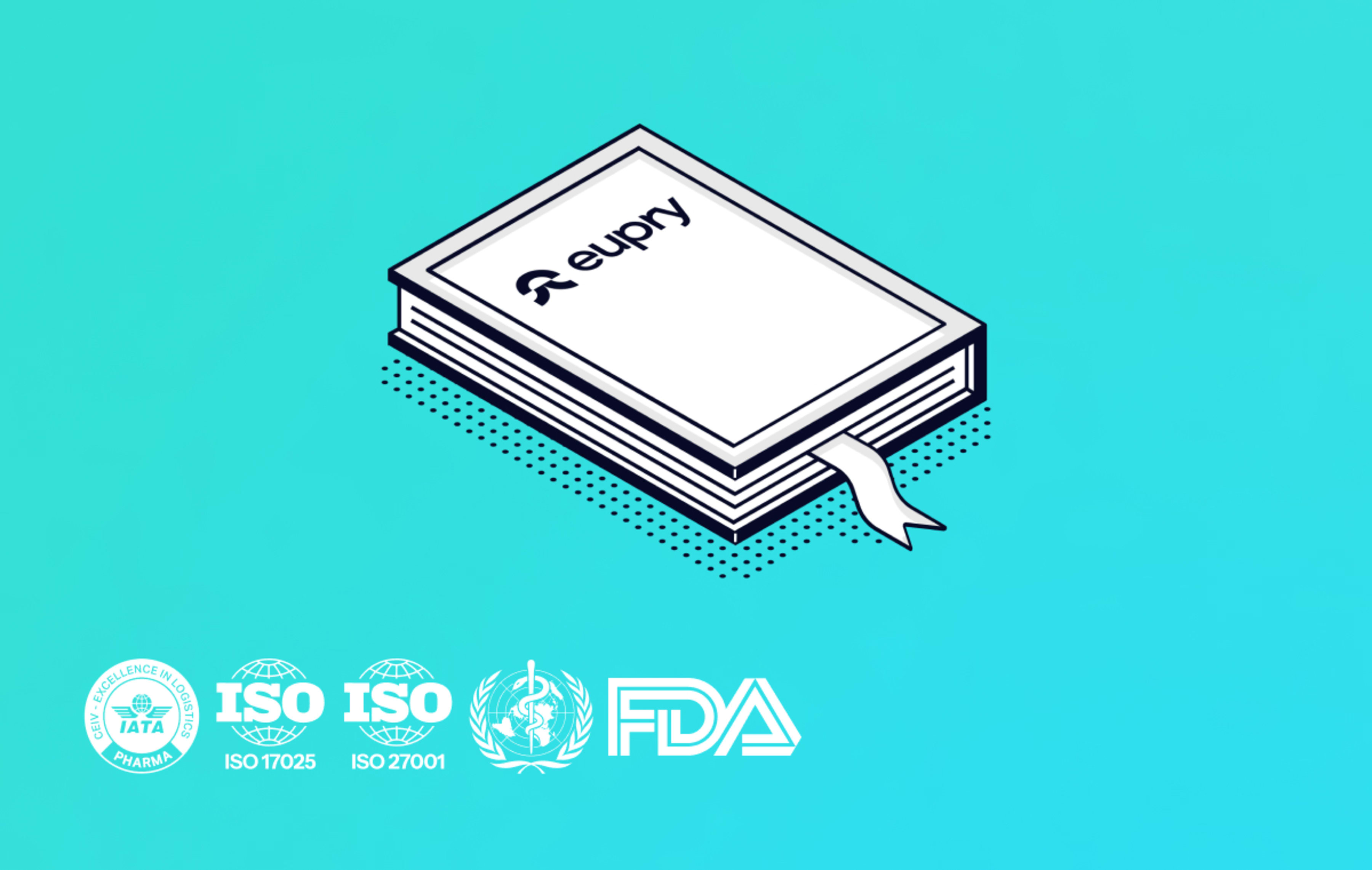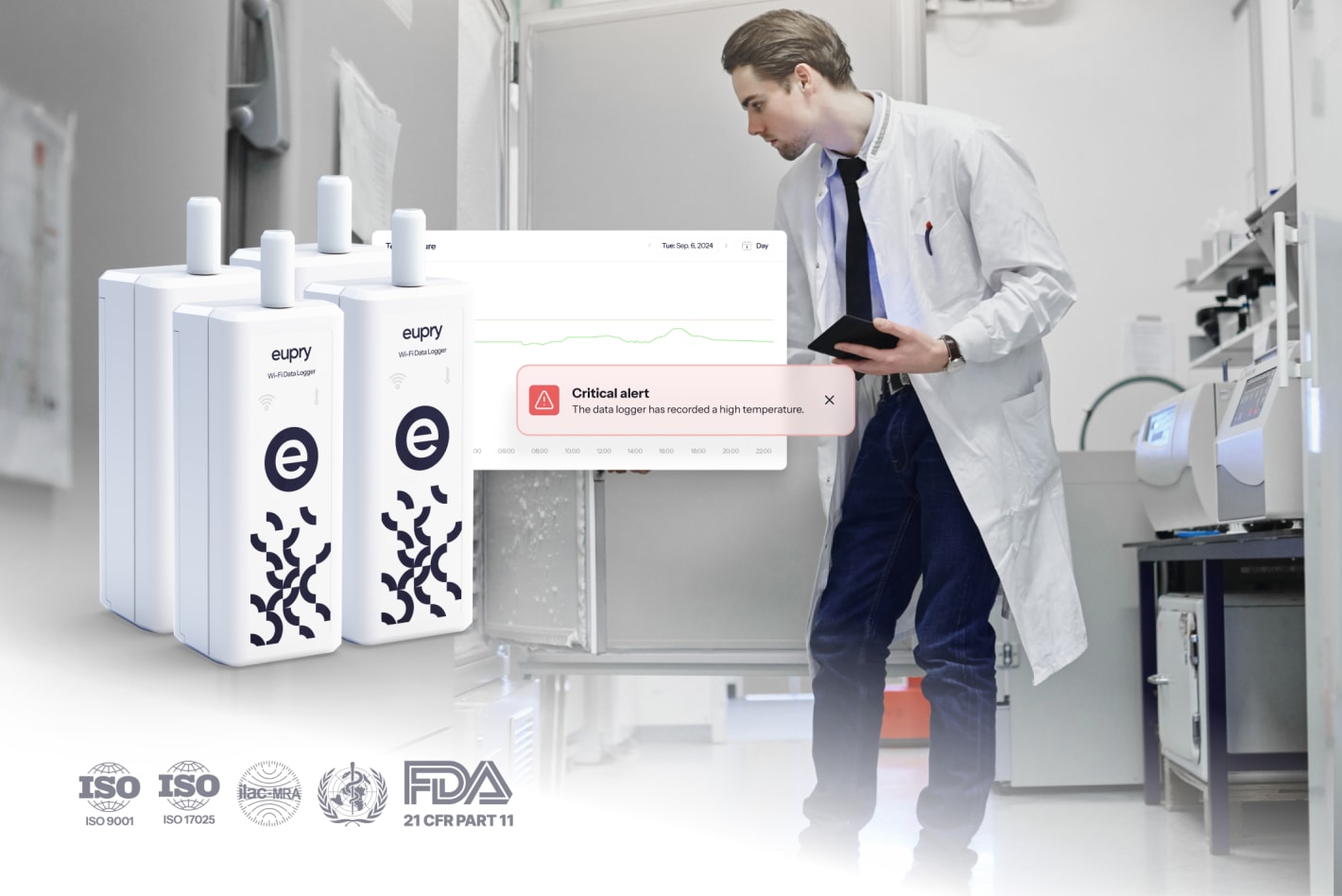The Eupry Glossary
Key GxP terminology explained

Adam Hartmann-Kruckow
Get a quick overview of the key terminology of temperature compliance and GxP – what it means, when it applies, and why it matters for compliance teams.

Table of contents
- Audits and inspections
- Calibration
- Cleaning and sterilization
- Cold chain and logistics
- Devices and sensors
- Digitalization and automation
- Excursion management
- GxP fundamentals
- Monitoring
- Pharmaceutical operations
- Quality management
- Regulatory frameworks
- Storage conditions
- Storage facilities and units
- Temperature mapping
- Validation

Audits and inspections
-
Alarm verification: A documented test proving that alarm thresholds, delays, notifications, and escalation work as intended. Typically performed during OQ and reverified at defined intervals.
-
Audit trail: A secure, chronological record of actions in a system. Critical for data integrity and traceability.
-
CAPA: Corrective and preventive action. Steps taken to fix and prevent quality or compliance issues.
-
Deviation report: A document that records any non-conformance, including what happened and how it was handled.
-
ALCOA plus: Expanded data integrity principles – crucial for audit acceptance.
-
Data access control: System permissions that restrict data access based on roles. Helps prevent unauthorized changes.
-
Temperature excursion: Any period where a monitored point goes outside defined limits. Excursions must be detected, documented, investigated, and linked to corrective and preventive actions.
Calibration
-
Accuracy vs. precision: Accuracy describes how close a measurement is to the true value. Precision reflects how consistently repeated measurements fall close to each other. Both are crucial for validation and audit defensibility.
-
As found/as left: Calibration results recorded before and after adjustment. Helps show drift over time and whether a probe was brought back within tolerance.
-
Calibration certificate: Official proof that a device (like a logger) has been tested and meets accuracy standards.
-
Calibration interval: The time between required calibrations. Too long – risk of drift; too short – wasted resources.
-
CMC/UCMC: Calibration Measurement Capability or Uncertainty of Measurement Capability - the best achievable measurement uncertainty of a calibration process.
-
DCR – digital calibration request: An electronic form or process used to request calibration, minimizing delays and manual paperwork.
-
DCC – digital calibration certificate: A digitally signed certificate proving a device has been calibrated, complete with traceability data.
-
Digital mapping software: Specialized software for planning, executing, and documenting temperature mapping studies digitally. Built to meet GxP requirements and minimize manual errors. Learn more about mapping software.
-
ISO 17025 accredited calibration: Calibration performed by a lab accredited under ISO 17025, ensuring technical competence and traceable, reproducible results. Learn more about ISO 17025 calibration.
-
NIST calibration: Calibration traceable to the standards of the National Institute of Standards and Technology (NIST). Often a requirement for multinational pharma clients.
-
On-the-wall calibration: On-site calibration method enabled by technology that makes it possible to perform calibration directly at the temperature-controlled unit of facility. Can typically be completed in minutes. Learn about the on-the-wall calibration approach.
-
Probe assignment: Traceable link between a calibrated probe or logger ID and its physical location or use. Certificates and monitoring records must reference the same unique IDs.
-
Quality dashboards: Unified digital interfaces providing visibility into alarms, calibration status, and monitoring trends across multiple locations. Supports proactive quality control and audit readiness.
- Reference gas calibration: Calibration method for CO₂ sensors using certified gas mixtures (typically 5% CO₂ in nitrogen). Required to maintain accuracy in incubator CO₂ monitoring systems. Should be performed at defined intervals per manufacturer specifications and GxP requirements.
- Traceability: The ability to trace a calibration result back to a national or international standard. Confirms the reliability of measurements.
Learn more about how you can save uo to 95% of the time you spend on calibration with Eupry's on-the-wall calibration.
Cleaning and sterilization
-
Autoclave: A pressure chamber used for steam sterilization of equipment, materials, and products in pharmaceutical and laboratory settings using saturated steam under pressure. Learn more about autoclave validation.
-
Biological indicator (BI): A test system containing viable microorganisms (typically Geobacillus stearothermophilus spores for steam sterilization) used to demonstrate that sterilization conditions achieve specified microbial kill.
-
Bowie-Dick test: A diagnostic test for pre-vacuum autoclaves using a chemical indicator pack placed in the chamber center to verify effective air removal and uniform steam penetration throughout the chamber.
-
CIP skid: Standalone CIP unit containing tanks, pumps, valves, and controls for delivering and recovering cleaning solutions across multiple process lines.
-
Clean–in–place (CIP): Automated cleaning process for internal equipment surfaces without disassembly, using controlled rinsing, detergent washing, and final rinsing to validated GMP limits. Learn more about clean-in-place (CIP) in pharma*
-
Cleaning validation: Documented process demonstrating that cleaning procedures remove residues to MACO or HBEL acceptance limits, including validated sampling and analysis.
-
D-value: Decimal reduction time – the time in minutes required at a specific temperature to reduce a microbial population by 90% (one log₁₀). Used to calculate sterilization cycle lethality.
-
Dryness fraction: The ratio of dry steam to total steam mass, expressed as a percentage. Production autoclaves require ≥0.95 (95% dry steam minimum) per EN 285; laboratory equipment may accept ≥0.90. Wet steam reduces heat transfer effectiveness and causes wet pack failures, impacting sterilization efficiency.
-
F zero value: A calculated value that measures sterilization efficacy over time, expressed as equivalent minutes at 121°C. Represents the accumulated lethality achieved during a steam sterilization cycle. Minimum F₀ of 12 minutes is the industry standard for overkill cycles. Central to validating steam sterilization.
-
Health–based exposure limit (HBEL): Safe exposure level for a substance used as a basis for cleaning validation acceptance criteria.
-
Maximum allowable carryover (MACO): The maximum amount of product residue allowed to carry over into the next batch without risk to patient safety, calculated from toxicological data.
-
Non-condensable gases: Air or other gases in steam that do not condense during sterilization, displacing steam and reducing sterilization effectiveness. Must not exceed 3.5% v/v per EN 285. High NCG indicates steam supply problems or inadequate air removal during pre-vacuum phases.
-
Overkill cycle: A sterilization cycle designed to achieve high lethality (typically F₀ ≥12 minutes at 121°C) without specific bioburden knowledge, providing conservative sterility assurance for routine loads.
-
Parametric release: A product release procedure based on demonstrated process control and compliance with critical validated parameters rather than end-product sterility testing, per EU GMP Annex 17.
-
Riboflavin coverage test: Visual method to verify CIP spray device coverage using riboflavin solution and UV light inspection. Also see: How to design CIP systems for pharma and biotech?*
-
Spray device: Component of CIP systems that distributes cleaning solution inside tanks or piping, such as spray balls or rotary jet heads.
-
Steam-in-place (SIP): Automated sterilization process using saturated steam after cleaning to eliminate microorganisms, achieving a validated sterility assurance level (SAL). See full guide: Complete guide to steam-in-place (SIP) validation in GxP*
-
Steam quality: A measure of how effectively steam can transfer heat - physical characteristics of steam including dryness fraction (≥0.95), non-condensable gas content (≤3.5% v/v), and superheat (≤25°C above saturation), defined in EN 285. High-quality steam meeting these parameters ensures effective sterilization outcomes.
-
Steam trap: A device that removes water from steam lines. Ensures consistent temperature and sterilization quality.
-
Sterility assurance level (SAL): Probability of a single viable microorganism surviving a sterilization process; typically 10⁻⁶ for GMP sterilization like SIP.
Z-value: The temperature increase in degrees Celsius required to reduce the D-value by 90%. For Geobacillus stearothermophilus spores used in steam sterilization, Z = 10°C.
Also see: Complete guide to steam-in-place (SIP) validation in GxP
Devices and sensors
-
Absolute pressure: The total pressure measured relative to a perfect vacuum. Relevant in CRYO storage or altitude-affected validation.
-
Data logger: A sensor device that records environmental data like temperature over time. Used in monitoring and mapping. Learn more about wireless data loggers built for GxP.
-
Differential pressure: The pressure difference between two points, used in cleanroom environments and critical zone containment.
-
External sensor: Any sensor connected to a data logger to monitor additional points—inside units, deep within loads, or in risk zones. Get an overview of Eupry's full GxP sensor selection here.
- Humidity sensor (capacitive): A sensor that measures relative humidity using a polymer or metal oxide film whose capacitance changes with moisture absorption. Prone to drift at high humidity levels (>80% RH) and requires regular calibration. Common in pharmaceutical storage applications.
-
Logger fittings: Accessories (e.g., clamps, holders) used to secure loggers during mapping to ensure stable readings.
-
Maximum permissible error (MPE): The maximum deviation allowed between a measuring instrument's reading and the true value, accounting for calibration, drift, and environmental factors. For data loggers, typically ±0.5°C or similar. You must factor MPE into acceptance limits by narrowing the acceptable range for recorded data.
- NDIR sensor: Non-dispersive infrared sensor technology used for CO₂ measurement in incubators. Measures gas concentration by detecting infrared light absorption at specific wavelengths.
-
PT100/PT1000: High-accuracy resistance temperature detectors (RTDs). PT1000 offers better noise immunity in long cables. Often used in ultra-low or high-accuracy validation setups.
-
Representative load: Items placed in a unit during mapping to mimic real thermal mass and airflow impact. Often includes product dummies or filled packs.
-
Thermocouple: A sensor made of two metals that generates a voltage proportional to temperature. Common in high-accuracy validations.
-
Transmitter: Sends sensor data to a central system. Key in real-time monitoring setups.
-
Wireless data logger: A logger that transmits data via Wi-Fi or radio, often in real time. Reduces manual work and supports automation. Learn more about wireless loggers.
Digitalization and automation
-
Digital validation: Using digital tools and software to plan, execute, and document validation activities. Speeds up audits and standardizes processes.
-
Automated calibration: A process that uses technology to handle calibrations without manual steps – often faster, with fewer errors.
-
Digital reporting: Auto-generated compliance reports you can export and present during audits. Cuts down audit prep time.
-
Central dashboard: A single interface showing data across sites and devices. Useful for quality teams managing multiple units or locations.
-
Unified temperature compliance: A streamlined approach that combines monitoring, mapping, and calibration in one process to reduce error and inefficiency. Learn why and how to unify your compliance.
Data loggers and digital solutions for GxP
One vendor, one solution, all you need for thermal compliance
Eupry brings temperature compliance – mapping, monitoring and calibration – into one digital, GxP-compliant solution.
Ensure compliance in less time, at a lower cost.
- 3-click audit reports and instant SMS/email alerts
- Live monitoring on phone, tablet, and desktop
- Automated calibration included
Instant access to all technical specifications, solution options, and more.

Excursion management
-
Excursion evaluation: Process of assessing the impact of a temperature deviation using MKT within USP <1079.2> windows. Every excursion must be documented. See also deviation handling
-
Excursion limits: Regulatory thresholds for excursions as defined in USP <1079.2>. Example: MKT ≤ 25 °C over 30 days for CRT.
-
Mean kinetic temperature (MKT): A calculated single temperature representing the cumulative thermal stress experienced by a product over time, giving more weight to higher temperatures. Defined in USP <1079.2> excursion evaluation.. Useful for evaluating temperature excursions but does not replace defined storage limits – MKT is supplementary.
-
Temperature excursion: Any deviation from the specified temperature range for a storage area or shipment. Can be brief and allowable (if predefined with proper justification) or represent true non-conformities requiring investigation. GDP and GMP require documented procedures for investigating and evaluating excursions.
GxP fundamentals
-
GxP: A set of quality guidelines and regulations covering Good practices (like manufacturing, distribution, and lab work) in life sciences. These rules help ensure that products are safe, consistent, and traceable. GxP is an umbrella term for more specific practices like GMP and GDP. Learn more about GxP compliance.
-
GMP: Stands for Good Manufacturing Practice. It ensures products are consistently produced and controlled according to quality standards. GMP covers manufacturing processes, equipment, and documentation. Learn more about GMP compliance.
-
GDP: Good Distribution Practice. Ensures that pharmaceutical products are stored and transported under appropriate conditions to maintain quality and integrity throughout the supply chain. Learn more about GDP compliance.
-
GLP: Good Laboratory Practice. Ensures the consistency, reliability, and integrity of non-clinical lab studies – often in R&D or product safety testing.
-
ALCOA plus: A framework for data integrity. It stands for Attributable, Legible, Contemporaneous, Original, and Accurate – with added expectations like Complete, Consistent, Enduring, and Available. Ensures trustworthy data during audits and regulatory reviews.
Industries: Cold chain and logistics
-
Cargo deck zones: Defined areas within an aircraft - upper deck, lower hold, door zones - monitored during aircraft mapping to detect thermal variation.
-
Cold chain: The end-to-end temperature-controlled supply chain. Ensures product safety from manufacturing to delivery.
-
Controlled temperature unit: Any storage or transport unit (like a fridge or truck) designed to maintain specific temperature ranges.
-
Ambient monitoring: Observing temperature and humidity in spaces not actively cooled (like warehouses). Still important for product safety.
-
Shipping validation: Testing and documenting that a shipment can maintain required conditions. Often needed for regulatory approval.
-
CEIV Pharma: A certification that confirms an organization meets GDP requirements for air cargo pharma transport. Learn more about CEIV Pharma certification.
-
GDP compliance: Meeting the standards of Good distribution practice – especially critical in pharma logistics.
-
Handover documentation: Records and responsibilities maintained during cargo transfer or short-term storage to uphold the chain-of-custody in pharma logistics. See warehouse compliance examples.
-
Unit Load Device (ULD): A container or pallet used to transport pharmaceutical cargo in aircraft; categorized as active (temperature-controlled) or passive (non-powered), where passive ULDs require validation via mapping. Learn more about ULDs.

Checklist for audit-ready temperature compliance in GDP
Download a step-by-step checklist for meeting GDP requirements in temperature monitoring, mapping, and calibration with everything auditors expect to see.
Industries: Pharmaceutical operations
-
Pharma-ready: A term used to describe operations, systems, or facilities that meet the specific regulatory and quality expectations of the pharmaceutical industry. Often implies GxP alignment, audit-readiness, and validated equipment.
-
Product supply: The logistics and quality-controlled delivery of pharmaceutical goods. Encompasses everything from manufacturing release to storage and distribution.
-
Pharma client expectations: The compliance, validation, and data transparency standards expected by pharmaceutical customers. Critical for logistics and service providers aiming to work with pharma.
-
Clinical trial supply chain: The controlled, often global distribution of investigational medicinal products (IMPs) used in clinical studies. Requires rigorous temperature monitoring and traceability.
-
Regulatory inspections: On-site evaluations by authorities (e.g., FDA, EMA) to assess compliance with pharmaceutical regulations. Passing is essential to maintain licenses and market access.
-
Pharmaceutical quality systems: The set of policies, SOPs, validations, and controls designed to ensure consistent product quality in pharma manufacturing and distribution.
Monitoring
Alarm acknowledgement: The action of confirming receipt of an alarm. Systems should log who acknowledged and when, and continue escalation if no action is taken.
Alarm delay: A configured time buffer before an alarm triggers to avoid false alerts during brief events like defrost cycles or door openings. Must be justified and documented.
-
Alarm strategy: A documented plan for setting alarm thresholds, defining responsibilities, escalation steps, and deviation documentation. Helps reduce false alerts and ensures GxP alignment. Read more.
-
Alert thresholds: The limits (e.g., max/min temperature) that trigger alarms when exceeded. Crucial for product safety and compliance.
-
Audit-ready monitoring data: Monitoring output that is complete, timestamped, and retrievable. Structured to meet GxP and regulatory expectations for audit trails.
- CO₂ monitoring: Continuous measurement of carbon dioxide concentration using NDIR (non-dispersive infrared) sensors. Critical for cell culture viability and requires reference gas calibration. Must be integrated with temperature and humidity monitoring for complete compliance.
-
Data integrity: The assurance that monitoring data is complete, accurate, and unchanged. Key for audits and regulatory acceptance.
-
Drift: The gradual change in the accuracy of a sensor over time. Even high-quality sensors drift and must be calibrated regularly to maintain traceability and audit-readiness.
-
Deviation handling: A structured way to respond when conditions fall outside thresholds. Includes documenting, investigating, and resolving the issue.
-
Escalation path: Defined sequence of people and channels that receive alarms if earlier recipients do not respond. Reduces single points of failure.
-
Excursion management: Process covering detection, initial response, product impact assessment, documentation, and CAPA for temperature excursions. Should be built into SOPs.
- Humidity monitoring: Continuous tracking of relative humidity (%RH). Humidity sensors require regular calibration due to drift at high humidity levels. Often combined with temperature monitoring in pharmaceutical and biotech applications.
-
Monitoring: The process of continuously observing temperature, humidity, or other environmental parameters to ensure compliance. Learn more about temperature monitoring in GxP.
-
Monitoring system: A digital setup that collects, stores, and displays temperature (and sometimes humidity) data from sensors in real time. It's the backbone of compliance visibility and proactive alerting. Systems must meet GxP and audit standards. Learn more about monitoring systems.
-
Real-time monitoring: Continuous tracking of temperature or humidity using connected sensors. Enables immediate alerts and audit readiness. Learn more about temperature monitoring.
-
Trend review cadence: A scheduled process for reviewing monitoring data, often monthly or quarterly, to refine sensor placement and thresholds based on trends and excursions.
Regulations and guidelines
-
Annex 11: Guidelines for the use of computerized systems in GxP environments within the EU. While not legally binding like 21 CFR Part 11 in the US, Annex 11 sets out expectations for data integrity, validation, and risk management when using digital systems in regulated processes. Especially relevant for selecting compliant monitoring systems. Learn more about Annex 11 requirements here.
-
Annex 15: A part of EU GMP guidance outlining expectations for qualification and validation. It defines principles for equipment, systems, and processes to be fit for purpose. Learn more about GMP Annex 15 requirements
-
ATEX: EU directive covering equipment and protective systems intended for use in potentially explosive atmospheres. Critical for data loggers and sensors used in facilities storing volatile APIs or chemicals.
-
DIN 13277: German standard defining performance and test requirements for medical refrigerators, including setpoints, alarms, recovery times, and functional checks. Useful as a benchmark for pharma refrigerators. See thermal compliance requirements for pharmaceutical refrigerators.
-
ICH Q9: A global guideline on quality risk management. Encourages risk-based approaches to decision-making in pharma processes and validation.
-
FDA: The US Food and Drug Administration. Sets regulations and enforces compliance for drugs, devices, and food in the United States.
-
FDA 21 CFR Part 11: A regulation from the U.S. FDA defining criteria under which electronic records and signatures are considered trustworthy and equivalent to paper records. Ensures digital records and e-signatures in your temperature compliance system are reliable and audit-ready. Read more about Part 11 compliance.
-
EMA: European Medicines Agency. Oversees evaluation and supervision of medicines in the EU, including GMP/GDP compliance.
-
EN 285: European standard specifying requirements and test methods for large steam sterilizers, including steam quality acceptance criteria for dryness fraction, non-condensable gas content, and superheat limits.
-
EU GMP Annex 15: EU guidance on qualification and validation, including cleaning validation, revalidation, and change control requirements in pharma manufacturing. Learn more about GMP requirements here.
-
ISO 17025: International standard for testing and calibration labs. Confirms lab competence, technical validity, and traceability. Learn more about ISO 17025 calibration.
-
ISO 17665: International standard for sterilization of health care products using moist heat, covering sterilization development, validation, and routine control. The 2024 update emphasizes lifecycle approaches and enhanced documentation.
-
MHRA: UK's Medicines and Healthcare products Regulatory Agency. Ensures that medicines and medical devices meet applicable standards.
-
NIS2 Directive: A European cybersecurity directive that sets new standards for digital resilience in essential sectors, including pharmaceuticals. Applies to systems storing or transmitting GxP data and requires documented risk management and breach reporting.
-
Responsible person (RP): In EU Good Distribution Practice (GDP), the individual designated to ensure a pharmaceutical wholesale distributor operates in compliance with GDP requirements. Must hold specific qualifications and has direct accountability for quality management, including temperature control and mapping activities. The RP typically reviews and approves mapping protocols, acceptance criteria, and final reports.
- USP <1079>: Guidance on good storage and distribution practices for drug products. Covers temperature-controlled storage, handling, and risk management from warehouse to point of use. See thermal compliance requirements for pharmaceutical refrigerators.
-
USP <1079.2>: Defines how to evaluate temperature excursions using mean kinetic temperature (MKT). Provides calculation windows, excursion thresholds, and documentation requirements for GDP/GMP compliance. Learn more here “USP <1079.2> explained”.
-
USP <1079.3>: Provides guidance on risk management for the storage and distribution of drug products, including assessing excursion impact.
-
USP <1079.4>: Gives recommendations for temperature mapping of storage areas and units, including study design, sensor placement, and acceptance criteria.
-
WHO TRS 961: World Health Organization technical report with practical guidance on temperature-controlled storage, mapping design, sensor placement, and monitoring for pharmaceutical facilities and units. Also see: What are the WHO’s guidelines for temperature mapping?
Storage conditions
-
Controlled ambient (20–25 °C): Narrow room‑temperature range used where tighter control than CRT is required. Common in pharma SOPs.
-
Controlled cold temperature (CCT) (2–8 °C): Pharmacopeial term for refrigerated storage. Use Refrigerated (2–8 °C) for everyday language; keep CCT as a synonym for search.
-
Controlled room temperature (CRT) (approx. 20–25 °C): Standard room‑temperature storage with defined excursion allowances.
-
Frozen (−20 °C): Defined frozen storage (freezer). Often written as Frozen (−20 °C) in SOPs.
-
Refrigerated (2–8 °C): Common industry term for +2 to +8 °C storage; equivalent to CCT.
-
Ultra‑low temperature (ULT, −70 to −90 °C): Ultra‑low or deep‑frozen storage used for advanced biologics. Often referred to by setpoint (e.g., −80 °C).
Storage facilities and units
-
Ambient storage (15°C to 25°C): Often overlooked, but critical for many tablets and finished goods. Deviation monitoring in ambient zones is increasingly expected by auditors.
-
Biological incubator: An incubator designed for microbiology and cell culture work, maintaining stable temperature and humidity without CO₂ control. Common in QC microbiology labs for sample incubation per USP requirements. Requires validation and continuous temperature monitoring.
- CO₂ incubator: A specialized incubator that maintains precise CO₂ concentration (typically 5%), temperature (typically 37°C), and humidity for mammalian cell culture applications. CO₂ sensors require calibration using reference gas mixtures, and drift is faster than temperature sensors. Used in pharmaceutical and biotech labs for cell-based assays and biologics development.
-
CRYO: Ultra-low temperature conditions below -130°C, often achieved using liquid nitrogen. Requires specialized monitoring due to extreme sensitivity and regulatory scrutiny.
-
CTU – container transport unit: A mobile unit or container used to transport temperature-sensitive products, requiring pre- and post-transport validation and monitoring.
-
Frozen storage (−20°C): Used for enzymes, some vaccines, and APIs. Requires GxP-compliant monitoring and calibration of freezers.
- Incubator: A temperature- and humidity-controlled chamber used in pharmaceutical, biotech, and microbiology labs for cell culture, microbiology samples, and stability studies. Requires IQ/OQ/PQ qualification, continuous monitoring of temperature, humidity, and (for CO₂ incubators) carbon dioxide levels. Learn more about Wi-Fi data loggers for incubators and how to handle thermal compliance for incubators.
- Stability chambers: Controlled environments used for product development, testing, and stability studies. Require high accuracy, minimal drift, and constant compliance visibility.
- Shaking incubator: An incubator combined with orbital or linear shaking motion to promote cell culture growth and mixing. Validation must account for both thermal performance and mechanical function.
-
Pharma cold storage: Temperature-controlled units storing medicines, vaccines, or APIs. This includes refrigerated (2–8 °C), frozen (below –20 °C), ultra-low freezers (around –80 °C), and controlled room temperature (15–25 °C) when required. Learn more about pharma cold storage applications.
-
Pharmaceutical refrigerators: A temperature-controlled unit designed for medicines, vaccines, and biologics. Expected to maintain +2 °C to +8 °C with alarms, continuous monitoring, calibration, and audit-ready records. Learn more Pharmaceutical refrigerators: Applications, validation, and monitoring.
-
Refrigerated storage (2°C to 8°C): Standard cold chain range used for most vaccines and biologics. Common across both pharma and logistics, and a key area for temperature deviation monitoring.
-
TCU – temperature controlled unit: A fixed unit—such as a refrigerator, incubator, or ULT freezer—used to store pharmaceutical goods under validated temperature ranges.
-
ULT – ultra-low temperature freezers: Refers to freezers that typically operate between -70ºC til -150ºC. The most common pharma setpoint is -80 °C. The specific acceptance criteria for a mapping study are product-dependent, meaning you should define the requirements based on the specific sensitive goods being stored. The goal of mapping is to ensure that these critical products are stored under conditions that do not adversely affect their efficacy or integrity.
Temperature mapping
-
Aircraft temperature mapping: A process involving calibrated data loggers placed in key zones of an aircraft cargo hold to monitor thermal performance during actual flight operations. Learn more about aircraft temperature mapping here.
-
Cold spot: A location that consistently records the lowest temperatures during mapping. Particularly important in refrigerated and frozen storage where temperatures dropping below the lower limit can damage products. Must be monitored continuously after mapping.
-
Continuous mapping: An approach that keeps collecting mapping-level data over time using many loggers. Helps avoid periodic re-mapping and ensures ongoing compliance. Learn more about continuous temperature mapping and our solution.
-
Defrost cycle test: Mapping test capturing temperature behavior during automatic defrost to confirm peaks stay within limits or recover within defined times.
-
ΔT (Delta T): The temperature difference between the warmest and coldest points in a mapped area during steady-state conditions. A key uniformity metric. Most protocols define a maximum acceptable ΔT based on product risk – for example, ≤2°C for a 2–8°C cold room.
-
Door-opening test: Challenge test simulating realistic door use to verify recovery time and uniformity remain within acceptance criteria. Learn more.
-
Freezer mapping: Techniques and best practices for validating ultra-low temperature units. Explore a freezer mapping guide.
-
GDP mapping: A mapping study that establishes the temperature distribution within a warehouse, vehicle, or storage unit lives up to GDP requirements. Learn more about GDP mapping.
-
Hot spot: A location within a mapped area that consistently records the highest temperatures during mapping. Once identified, you should place at least one continuous monitoring sensor there. GDP requires monitoring at extremes identified during mapping.
-
Hot and cold spots: The highest and lowest temperature zones within a unit or space. These are critical to identify during mapping.
- Incubator mapping: Temperature (and humidity/CO₂) mapping study of incubators following protocols similar to refrigerator mapping but accounting for higher humidity and CO₂ presence. Learn more about how to obtain thermal compliance for incubators in GxP
-
Mapping data logger calculator: Use our calculator tool to estimate logger requirements for your mapping study.
-
Mapping grid: A planned pattern of sensor locations that covers extremes and representative zones. Typical small fridges use a 9-point grid; larger cabinets may use 15–21 points or more, based on risk. See mapping of pharmaceutical refrigerators.
-
Mapping protocol: The plan that outlines how a temperature mapping study is performed, including sensor placement, duration, and acceptance criteria. See our mapping protocol template.
-
Non-conformities: Events or results that fall outside defined acceptance criteria during validation or mapping. Must be documented and resolved.
-
Pharma cold room mapping: A thermal validation study documenting uniform temperature distribution in pharmaceutical cold rooms, ensuring GDP and GMP compliance. Learn more about pharma cold room mapping.
-
Power-failure simulation: Controlled test to document warm-up time to limits and alarm behavior if power is lost. Results inform risk assessments and SOPs.
-
Recovery time: Time required for a unit to return within defined limits after a disturbance such as a door opening or defrost. Part of acceptance criteria. See mapping of pharmaceutical refrigerators.
-
Reefer temperature mapping: The process of of verifying that a refrigerated shipping container (a reefer) consitently maintains required pharmaceutical storage temperatures. Learn more about GDP-compliant reefer temperature mapping for pharmaceuticals.
-
Remote mapping service: A remote-led mapping service where specialists support your team through every step – minimizing onsite workload and ensuring compliant execution. Learn more.
-
Risk-based mapping: A validation method where mapping efforts focus on higher-risk areas or units. Saves time while meeting compliance. Learn more in our risk-based mapping guide.
-
Risk-based re-qualification: Repeating mapping or qualification when triggered by risk events – layout changes, HVAC modifications, seasonal shifts, or alarming trends – rather than fixed intervals. Read more.
-
Sensor density: Number of sensors per volume or risk level used during mapping. Determined by unit size, airflow patterns, product risk, and regulatory expectations.
-
Sensor placement: Strategic positioning of loggers in high-risk or extreme zones (like hot/cold spots) to ensure accurate mapping data. See our guide on sensor placement best practices.
-
Stability (control point): Allowable drift at the control sensor over time during steady-state mapping. Used alongside uniformity to judge performance.
-
Temperature uniformity: The degree to which temperature is evenly distributed throughout a storage area. Good uniformity means minimal temperature variation – in other words, a low ΔT. Assessed during steady-state conditions in mapping studies.
-
Thermal mass: The ability of materials to absorb and retain heat, resisting rapid temperature changes. This is why the internal temperature of packaged products changes more slowly than surrounding air temperature, allowing you to define short-term allowable excursions with proper justification.
Uniformity: Maximum allowed difference between hottest and coldest mapping points during steady state. Confirms consistent conditions across the load space. See mapping of pharmaceutical refrigerators.
-
Warehouse zoning: Defining specific areas within a warehouse, such as loading bays, mezzanines, or temperature-specific rooms, each with its own mapped compliance requirements.
-
Worst-case load: The most challenging load configuration for sterilization or thermal validation, defined by maximum chamber capacity, densest materials, most restrictive packaging, or combinations of these factors. Used to prove equipment can handle any routine condition.
-
Worst-case placement: A logger positioning strategy targeting areas most likely to encounter temperature extremes, such as near doors, windows, and technical installations.
-
Worst-case conditions: The most challenging environmental or operational conditions a storage area is likely to experience. In mapping, this typically means testing during the hottest season for refrigerated storage or coldest season for heated ambient storage. WHO and GDP guidance emphasize mapping under worst-case scenarios.

Guide: Continuous temperature mapping in GxP
Get a step-by-step guideline the continuous temperature mapping framework - what it is, when to use it, and how to implement it.
Validation
-
Acceptance criteria: Predefined limits that determine if a test or validation passes or fails. Critical for audit transparency.
-
Change control trigger for requalification: Defined events that require repeating parts of IQ, OQ, or PQ. Typical triggers include relocation, major service, firmware updates, load profile changes, and recurring excursions.
-
Cleaning validation: Documented process demonstrating that cleaning procedures remove residues to MACO or HBEL acceptance limits, including validated sampling and analysis. See full guide: Clean in place (CIP) in pharmaceuticals and biotech
-
CQV (commissioning, qualification, validation): An integrated validation approach combining engineering with GxP to reduce risk and delays. Learn more about CQV validation in pharma.
-
DQ: Design qualification. Verifies that equipment or systems are designed correctly and meet intended use before installation.
-
IQ (installation qualification): Confirms equipment is installed per manufacturer specs and site requirements and is often the first step in GxP validation. More on IQ, OQ, PQ.
-
Lane qualification: A documented validation process confirming that a specific aircraft route and compartment maintain required temperature conditions, enabling safe transport of temperature-sensitive medicines. Learn more about aircraft temperature mapping here.
-
Mean Kinetic Temperature (MKT): A calculated metric that represents the aggregated effect of temperature fluctuations over time, used to assess thermal exposure during mapping studies.
-
OQ (operational qualification): Verifies that equipment performs as expected under defined conditions, typically follows IQ. Explore OQ.
-
PQ (performance qualification): Confirms consistent performance in real-world use - final step before commercial operation. Learn more about PQ.
-
PQ with mapping: Performance qualification that includes a full mapping study under representative load and use. Confirms the unit performs as intended in real operation.
-
System validation: The documented process of proving that a software or monitoring system performs as intended, reliably, reproducibly, and compliantly. It is required for all GxP-related digital tools to ensure compliance and audit readiness.
-
Validation fatigue: A common issue when over-validation leads to wasted time and resources. Often caused by unclear risk prioritization.
-
VMP (validation master plan): A high-level document outlining validation strategy, responsibilities, systems, and timelines.
Learn more in our thermal validation guide.

6-step thermal validation checklist
Get a step-by-step PDF for planning and documenting GxP-compliant validation.
Quality management
-
Corrective and preventive actions (CAPA)
Required if repeated excursions indicate poor system control. Supports GMP and GDP compliance expectations. -
GDocP
Good documentation practices. Guidelines on how to write, update, and store records to meet regulatory expectations. -
Internal audit
A self-check of systems and processes. Used to catch issues before external inspections. -
KPI
Key performance indicator. A measurable value that shows how well a process or system is performing (e.g., alert resolution time). -
Nonconformity (excursion)
Under USP <1079.2>, every excursion is a nonconforming event. Requires documentation, QA review, and justification, even if MKT is within limits. -
Quality deviation
A documented departure from expected process or outcomes. Triggers investigations and sometimes CAPAs. -
SOP
Standard operating procedure. A written instruction detailing how to perform a task. Ensures consistency and compliance.


